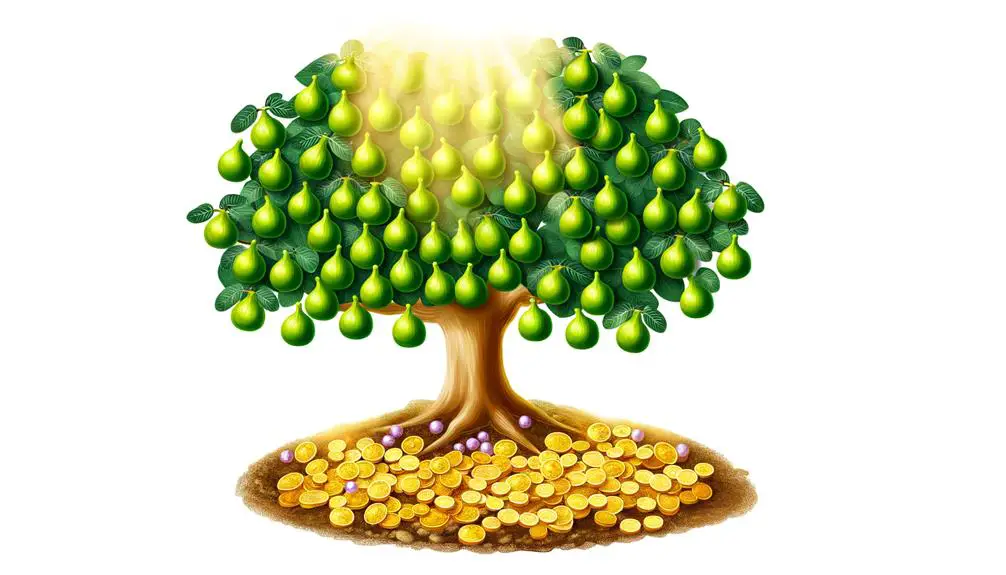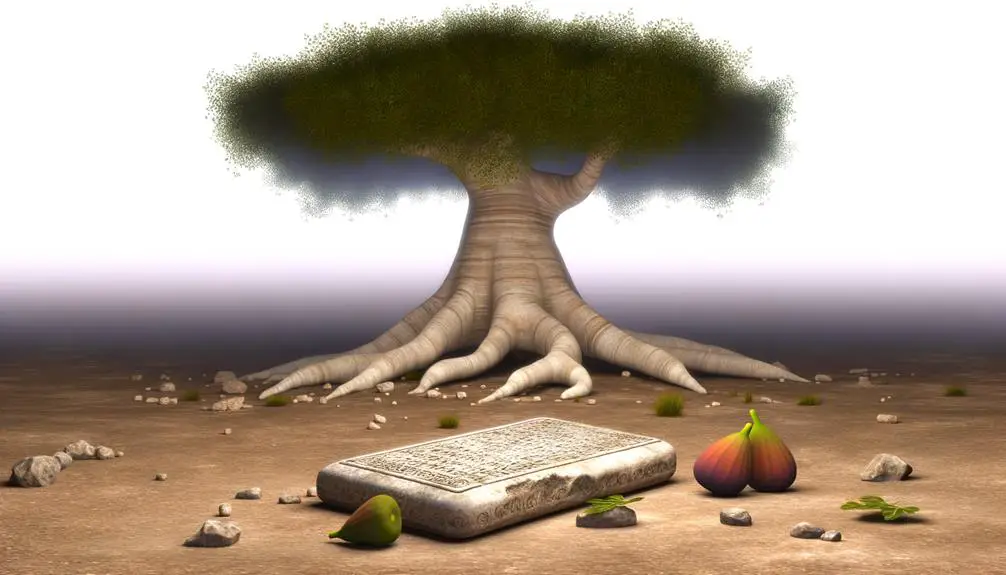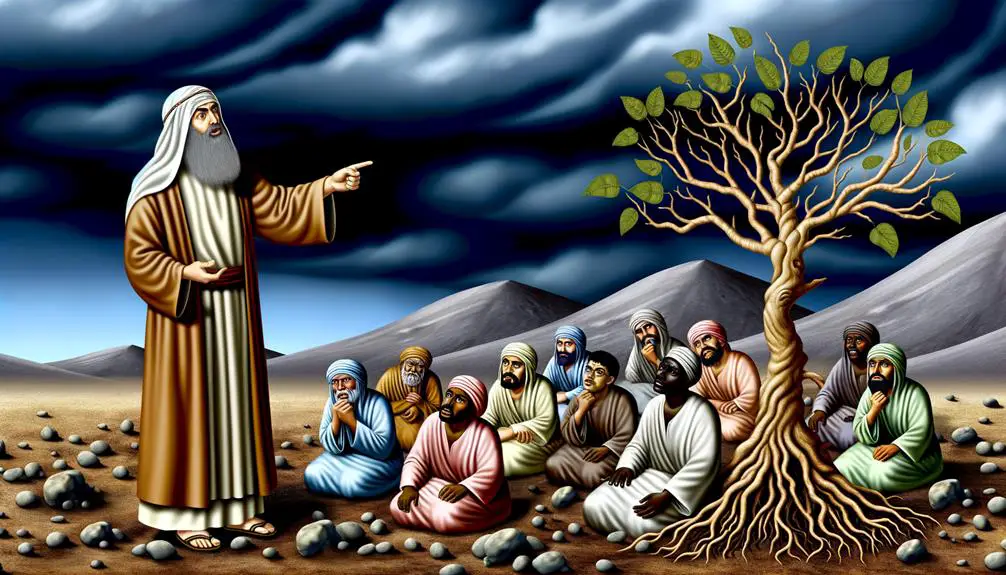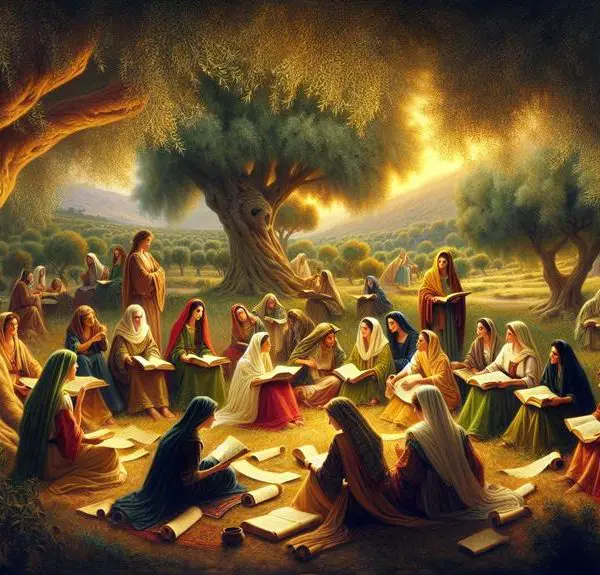The fig tree in the Bible encapsulates themes of growth and divine judgment, beckoning a deeper exploration into its symbolic layers.

Fig Tree Symbolism in the Bible
While you might think that the fig tree is just another plant mentioned in the Bible, its symbolism is deeply woven into the fabric of biblical narratives, offering you insights into themes of prosperity, judgment, and redemption.
From its roots in the Garden of Eden to Jesus' interaction with the barren fig tree, this plant carries with it layers of meaning that resonate through the ages.
As you consider its role in representing both sustenance and divine judgment, you'll find the fig tree's imagery invites a deeper exploration into the complexities of faith and the human condition.
Let's uncover the rich symbolism this tree holds and what it reveals about the broader biblical message.
Key Takeaways
- The fig tree symbolizes knowledge, temptation, and the consequences of human curiosity from the story of Adam and Eve.
- It embodies prosperity and spiritual wealth, reflecting God's provision and the link between faith and material blessings.
- The barren fig tree represents divine judgment, warning against spiritual barrenness and the importance of nurturing faith.
- Through Jesus' encounter with the barren fig tree, it serves as a metaphor for spiritual growth and the necessity of productive faith.
The Garden of Eden

In the context of the Garden of Eden, the fig tree emerges as a symbol of knowledge and temptation, pointing to the pivotal moment when humanity's innocence was lost. This narrative, deeply ingrained in Judeo-Christian theology, underscores the fig tree's role in the story of original sin, a theme that has been the subject of theological scrutiny and interpretation for centuries.
The fig tree's leaves, which Adam and Eve used to cover their nakedness, signify the awakening of human consciousness to sin and morality, following their consumption of the forbidden fruit. This act, driven by the serpent's deceit, marks the genesis of mankind's eternal struggle between virtue and vice.
The fig tree, therefore, isn't merely a backdrop in the Eden narrative but a potent symbol intertwined with the very essence of original sin. Its presence underscores the gravity of Adam and Eve's decision, influenced by the serpent's deceit, to defy divine command. This defiance isn't just a moment of disobedience but a transformative episode that illustrates the complex interplay of temptation, knowledge, and the loss of innocence. The fig tree's association with this moment highlights its symbolic significance beyond a mere plant, embodying themes of enlightenment and the inevitable consequence of human curiosity.
Analyzing the fig tree's role in this narrative offers insights into the nuanced understanding of original sin and the serpent's deceit. It serves as a reminder of the profound implications of Adam and Eve's actions, setting the stage for the enduring theme of redemption in biblical literature. Through this lens, the fig tree transcends its botanical identity, becoming a symbol of the complex human condition, marked by a perpetual quest for knowledge and the relentless allure of temptation.
Symbol of Prosperity

As you explore the fig tree's role in biblical narratives, you'll notice it isn't merely a plant; it embodies prosperity's deep roots in spiritual context.
The fig tree parables, for instance, offer rich insights into how prosperity was understood and symbolized in ancient texts.
Analyzing these stories sheds light on the complex interplay between material wealth and spiritual abundance within biblical teachings.
Prosperity's Biblical Roots
Throughout the Bible, the fig tree emerges as a powerful symbol of prosperity, underscoring the deep-rooted connection between spiritual faith and material abundance. This imagery isn't accidental but rather a deliberate choice to convey complex ideas through agricultural metaphors, reflecting the society's reliance on agriculture and the equitable distribution of wealth as divine blessings.
Consider these elements:
- Agricultural Metaphors: They serve as relatable, tangible examples of spiritual truths, making abstract concepts accessible.
- Wealth Distribution: The fig tree's abundance symbolizes God's desire for His people's prosperity and communal well-being.
- Spiritual Faith: It's linked with material blessings, suggesting a covenant of prosperity for faithfulness.
- Material Abundance: Reflects God's provision and care, reinforcing the belief in a benevolent Creator.
Fig Tree Parables
Building on the foundational understanding of fig trees as symbols of prosperity in biblical narratives, we now explore how fig tree parables further elaborate this motif, offering profound insights into the nature of spiritual and material wealth. These parables weave seasonal metaphors and agricultural practices into their narratives, emphasizing the importance of timely growth and the consequences of barrenness.
Keyword |
Application in Parables |
Significance |
|---|---|---|
Seasonal Metaphors |
Timing of fruit production |
Reflects spiritual readiness |
Agricultural Practices |
Care for fig trees |
Symbolizes diligence in faith |
Prosperity |
Abundance of figs |
Represents divine blessing |
Spiritual Wealth |
Fruit as a metaphor |
Signifies inner growth |
Material Wealth |
Harvest of figs |
Analogous to earthly success |
Through these parables, the fig tree becomes a powerful symbol, teaching lessons about growth, patience, and the rewards of a nurtured spiritual life.
A Sign of Judgment

You'll find that the fig tree's symbolism extends beyond prosperity, serving as a potent sign of judgment within biblical narratives.
The cursing of the fig tree exemplifies divine displeasure, while its role as a prophetic judgment symbol underscores its significance in eschatological contexts.
Additionally, interpretations of parables involving the fig tree reveal layers of meaning about divine judgment and the expectations placed upon the faithful.
Fig Tree Curse
In the biblical narrative, Jesus' cursing of the fig tree serves as a potent symbol of divine judgment and a warning against spiritual barrenness. This act isn't merely a miraculous display but deeply embedded in the socio-religious context, touching on agricultural implications and cultural perceptions. To elaborate:
- Agricultural Implications: The fig tree was central to local economy and sustenance, its curse underscoring the severity of divine disapproval.
- Cultural Perceptions: Fig trees symbolized prosperity and peace, their withering signifying divine displeasure.
- Spiritual Barrenness: The lack of fruit symbolizes a lack of faith and righteousness.
- Divine Judgment: The act prefigures the inevitable consequences of spiritual neglect.
This narrative layer enriches our understanding of the fig tree's role as a symbol in biblical literature, inviting a deeper reflection on spiritual vitality.
Prophetic Judgment Symbol
Beyond the physical realm, the fig tree's cursing symbolizes a prophetic judgment, serving as a stark reminder of the consequences awaiting spiritual complacency.
In biblical narratives, this act isn't merely about agriculture but intertwines with themes of divine retribution. The imagery of a withering fig tree parallels ancient rituals invoking protection against natural disasters, a metaphor for the divine shaking the foundations of those not rooted in faith.
Such narratives underscore the belief that spiritual barrenness leads to inevitable downfall, akin to how societies vulnerable to natural calamities often interpret these events as heavenly signs.
This symbolism extends beyond the natural world, illustrating a theological principle: without spiritual fruitfulness, one faces judgment, reflecting a profound intersection of faith, morality, and the natural order.
Parable Interpretations
While interpreting the parable of the fig tree as a sign of judgment, it's imperative to recognize how this narrative serves as a nuanced critique of spiritual stagnation. The fig tree, barren and fruitless, embodies the consequences of failing to live up to the moral teachings embedded within the scriptures. This parable poses interpretative challenges, demanding a deep understanding beyond literal interpretation.
- A withered fig tree, symbolizing wasted potential and divine discontent.
- The unexpected moment of judgment, illustrating the suddenness of spiritual reckoning.
- Fruitlessness as a metaphor for moral and spiritual failure.
- The call to repentance, a beacon of hope amidst the stark warning.
This analysis offers a comprehensive view of the fig tree as a powerful emblem of judgment and redemption in biblical literature.
Lessons in Forgiveness

The fig tree's narrative in the Bible offers profound insights into the nature of forgiveness, illustrating how it serves as both a personal release and a divine command. You'll find that forgiveness, much like the fig tree, symbolizes a healing process and the potential for relationship restoration. This act, deeply rooted in scripture, isn't merely about forgetting wrongs but about fostering a profound transformation within individuals and communities.
Aspect |
Significance |
|---|---|
Healing Process |
Forgiveness initiates emotional and spiritual healing, much like the nurturing growth of a fig tree from barren to fruitful. |
Relationship Restoration |
It acts as a bridge to mend and restore broken relationships, symbolizing regeneration and new beginnings. |
Divine Command |
Like the fig tree serving multiple purposes in biblical narratives, forgiveness is multifaceted, embodying both a divine expectation and a pathway to divine alignment. |
Personal Release |
Embracing forgiveness allows one to break free from the shackles of resentment, akin to shedding old leaves for new growth. |
Community Transformation |
Collective forgiveness can lead to societal healing and unity, mirroring the communal significance of the fig tree in ancient cultures. |
Analyzing forgiveness through the lens of fig tree symbolism enriches our understanding of its complexity and depth. It's not just about letting go of grievances but about nurturing growth and renewal in every aspect of life. This biblical metaphor underscores the transformative power of forgiveness, urging you toward a path of healing, unity, and spiritual revival.
Jesus and the Barren Tree

Having explored the rich symbolism of the fig tree in relation to forgiveness, let's now examine a contrasting biblical narrative: Jesus' encounter with the barren fig tree. This story, rich in metaphor and meaning, offers a compelling exploration of expectation, productivity, and divine judgment.
- The Encounter: Jesus, hungry and expecting to find fruit, approaches the fig tree. Despite its lush leaves, signifying health and potential, the tree bears no fruit. This moment encapsulates the expectation of productivity and the stark reality of barrenness.
- The Curse: Jesus' response to the barren tree is immediate and irreversible: He curses it, and it withers. This dramatic action serves as a powerful metaphor for divine judgment upon unfruitfulness, highlighting the consequences of failing to fulfill one's purpose.
- Cultivation Techniques: In the context of this narrative, the barren fig tree can be seen as a failure not just of the tree itself but of the cultivation techniques employed. This points to a broader spiritual metaphor about the importance of nurturing faith and good works.
- Seasonal Metaphors: The story uses seasonal metaphors to underscore the expectation of fruitfulness. Fig trees, known for their cyclic nature, become a symbol for the cycles of spiritual growth and decline.
Analytically, this narrative isn't merely about agricultural practices or seasonal changes. It delves deeper into the spiritual realm, challenging believers to reflect on their own productivity and spiritual health. The barren fig tree becomes a mirror, reflecting back the consequences of spiritual neglect and the imperative of bearing fruit in one's life.
Fig Leaves as Clothing

In exploring the multifaceted symbolism of the fig tree within biblical texts, one can't overlook its earliest mention as a source of clothing for Adam and Eve, marking a pivotal moment in human self-awareness and moral awakening. This narrative not only underscores the fig tree's integral role in humanity's initial steps towards modesty and morality but also highlights a moment of profound realization and creativity under duress.
At the heart of this episode is Adam's embarrassment and Eve's innovation. Their sudden awareness of their nakedness, following the consumption of the forbidden fruit, triggers a cascade of emotions and actions that have profound theological and symbolic implications. The choice of fig leaves, in particular, is emblematic of humanity's initial attempt to address guilt and vulnerability. Eve's quick thinking to fashion these leaves into makeshift garments illustrates a moment of ingenuity amidst a crisis of morality and identity.
The act of covering themselves with fig leaves serves as a tangible manifestation of the newfound knowledge of good and evil. It's a poignant symbol of the loss of innocence and the beginning of human culture as we know it. Moreover, the specific mention of 'fig leaves' rather than any other foliage emphasizes the fig tree's significance in biblical lore, hinting at deeper layers of meaning and symbolism that extend beyond this singular narrative.
This episode, therefore, not only marks the beginning of humanity's complex relationship with morality and modesty but also sets the stage for the fig tree's enduring symbolic presence throughout the biblical text, weaving a rich tapestry of meaning that spans from the earliest chapters of Genesis onwards.
Eternal Life Imagery

Beyond its initial role in human modesty, the fig tree also embodies the concept of eternal life within biblical texts, serving as a profound symbol that intertwines with themes of redemption and divine promise. The fig tree's representation extends beyond its physical form, encapsulating deep spiritual significances that reflect on the immortality concept and serve as a resurrection metaphor. Through its recurring presence, the fig tree nurtures a rich tapestry of imagery that highlights the promise of eternal life, underscoring the transformative journey from mortality to an everlasting existence with the divine.
To create vivid imagery in your mind, consider the following aspects:
- The Unfailing Fruit: The fig tree's ability to bear fruit in every season mirrors the promise of eternal life, suggesting a state of perpetual abundance and spiritual nourishment that transcends earthly limitations.
- The Resilient Growth: Symbolizing resilience and continuity, the fig tree's robust growth even in harsh conditions reflects the soul's journey towards eternal life, overcoming worldly challenges through faith and divine grace.
- The Protective Shade: Just as the fig tree offers shade and shelter, it symbolizes the protection and comfort provided by faith in the face of life's adversities, pointing towards the rest and peace found in the concept of eternal life.
- The Blooming Leaves: The flourishing leaves of the fig tree serve as a visual metaphor for resurrection, representing new life and renewal, and the triumph over death through the promise of eternal existence.
Analyzing these elements reveals how the fig tree transcends its physical presence, embodying a deeper, spiritual significance that aligns with the themes of immortality and resurrection, and enriching the biblical narrative with layers of meaning concerning eternal life.
Frequently Asked Questions
How Has the Interpretation of Fig Tree Symbolism Changed Over Different Periods in Christian History?
In exploring how interpretations have evolved, you're delving into a rich tapestry of historical context and interpretive techniques.
Initially, interpretations were more literal, focusing on direct biblical narratives. Over time, scholars have applied nuanced analytical lenses, seeing the fig tree as a symbol of deeper spiritual truths and shifts in theological thought.
This evolution reflects broader changes in Christian history, where interpretive techniques have become more sophisticated, mirroring shifts in societal and cultural understandings.
Are There Any Significant Differences in Fig Tree Symbolism Between Various Denominations or Sects Within Christianity?
Yes, there are notable differences in how denominations and sects within Christianity interpret fig tree symbolism. These denominational interpretations and sect-specific symbolisms reflect diverse theological perspectives and historical contexts.
Some see it as a sign of prosperity and peace, while others might interpret it as a warning or a call to faithfulness. Analyzing these varied interpretations offers a rich, detailed understanding of the fig tree's symbolic significance across Christian traditions.
Can the Fig Tree Symbol Be Linked to Similar Symbols in Other Major World Religions, and if So, How?
Interestingly, you'll find that across major world religions, symbols akin to the fig tree emerge, revealing cross-cultural comparisons.
Delving into this, symbolic parallels between the fig tree in Christianity and similar symbols in other traditions offer rich insights.
These parallels not only highlight shared spiritual values but also underscore common human experiences transcending religious boundaries.
Analyzing these connections provides a deeper understanding of how diverse cultures interpret and value the natural world.
How Do Modern Theologians View the Relevance of Fig Tree Symbolism in Contemporary Christian Practice and Belief?
Modern theologians often view fig tree symbolism through ecological perspectives and artistic representations, seeing it as a bridge to contemporary Christian practice and belief. They analyze how this imagery resonates with themes of growth, sustenance, and renewal, drawing parallels to environmental stewardship and community nurturing.
Through scholarly examination, they've highlighted its relevance in artistic depictions within churches and literature, enriching believers' understanding and connection to faith in today's context.
What Psychological or Cultural Factors Might Explain the Enduring Power of Fig Tree Imagery in Biblical Narratives and Teachings?
You're exploring why certain images, like the fig tree, stick in our minds and beliefs.
The cultural resonance of such symbols taps into shared histories and values, making them powerful tools for teaching and understanding.
Their psychological impact can't be understated either; they evoke emotions and memories, connecting deeply with our personal and collective psyches.
This combination ensures they remain relevant and influential in narratives and teachings, transcending their original contexts.
Conclusion
In sum, the fig tree in the Bible isn't merely a plant; it's a colossal beacon of spiritual symbolism. From Eden's lush groves to the stark lesson of the barren tree Jesus encountered, it whispers tales of prosperity, judgment, and forgiveness.
It's as if every leaf and fig whispers ancient secrets of divine truths. The fig tree, with its robust roots in biblical narratives, serves as an enduring emblem of life's cyclical nature and the eternal quest for spiritual enlightenment.



Sign up